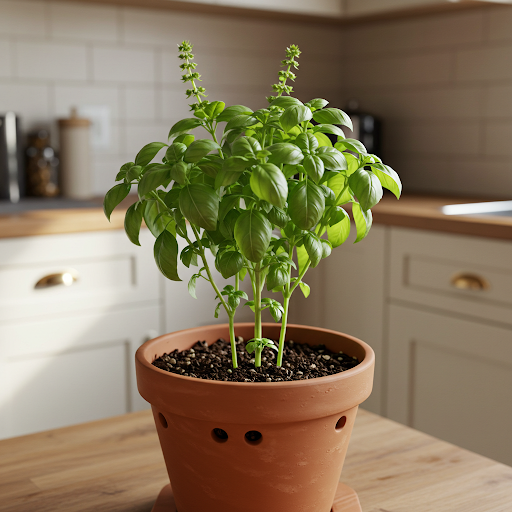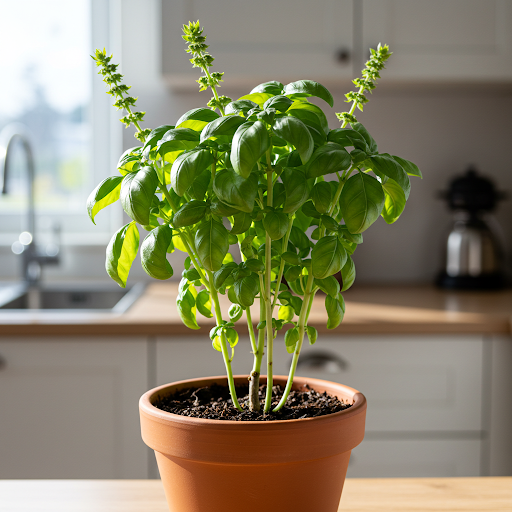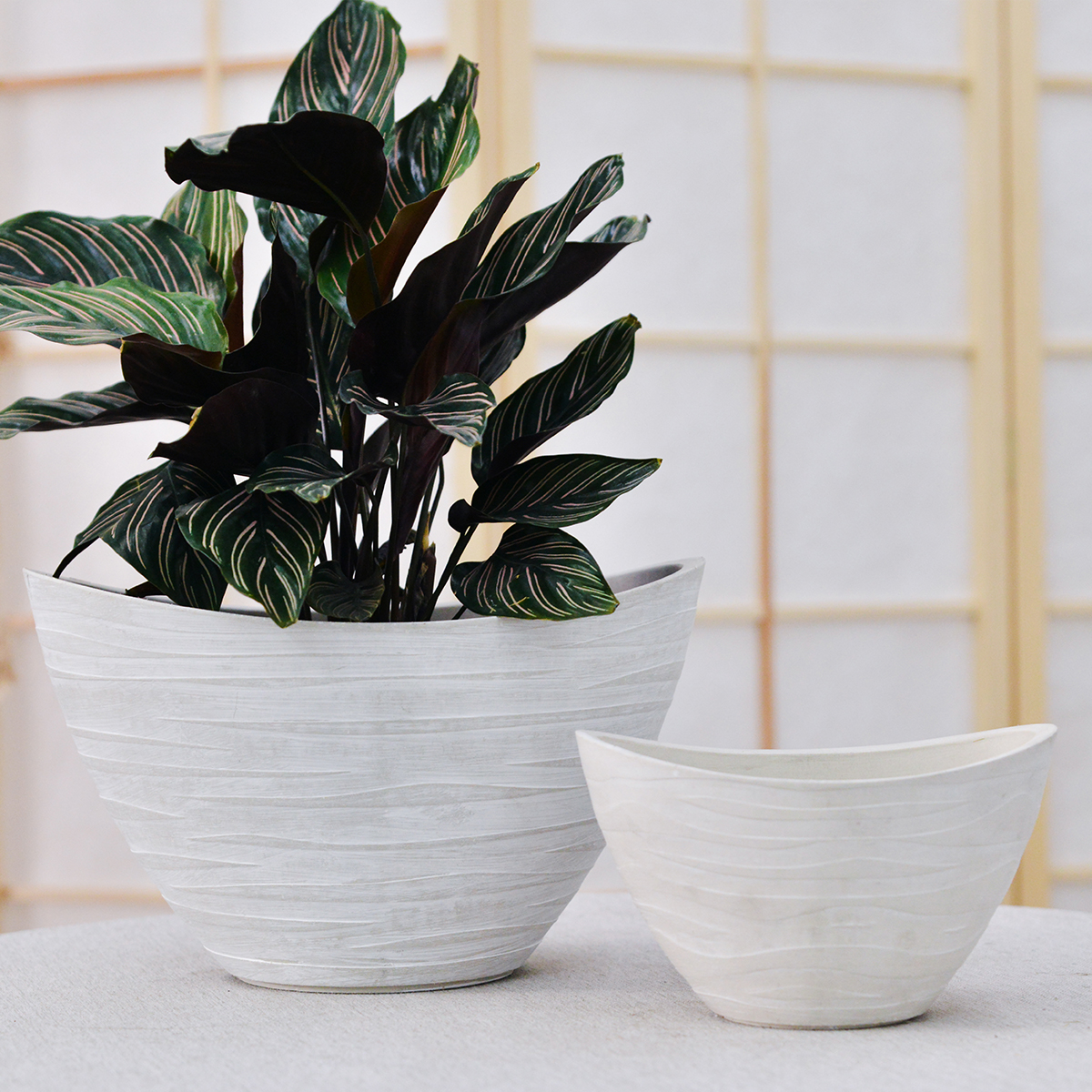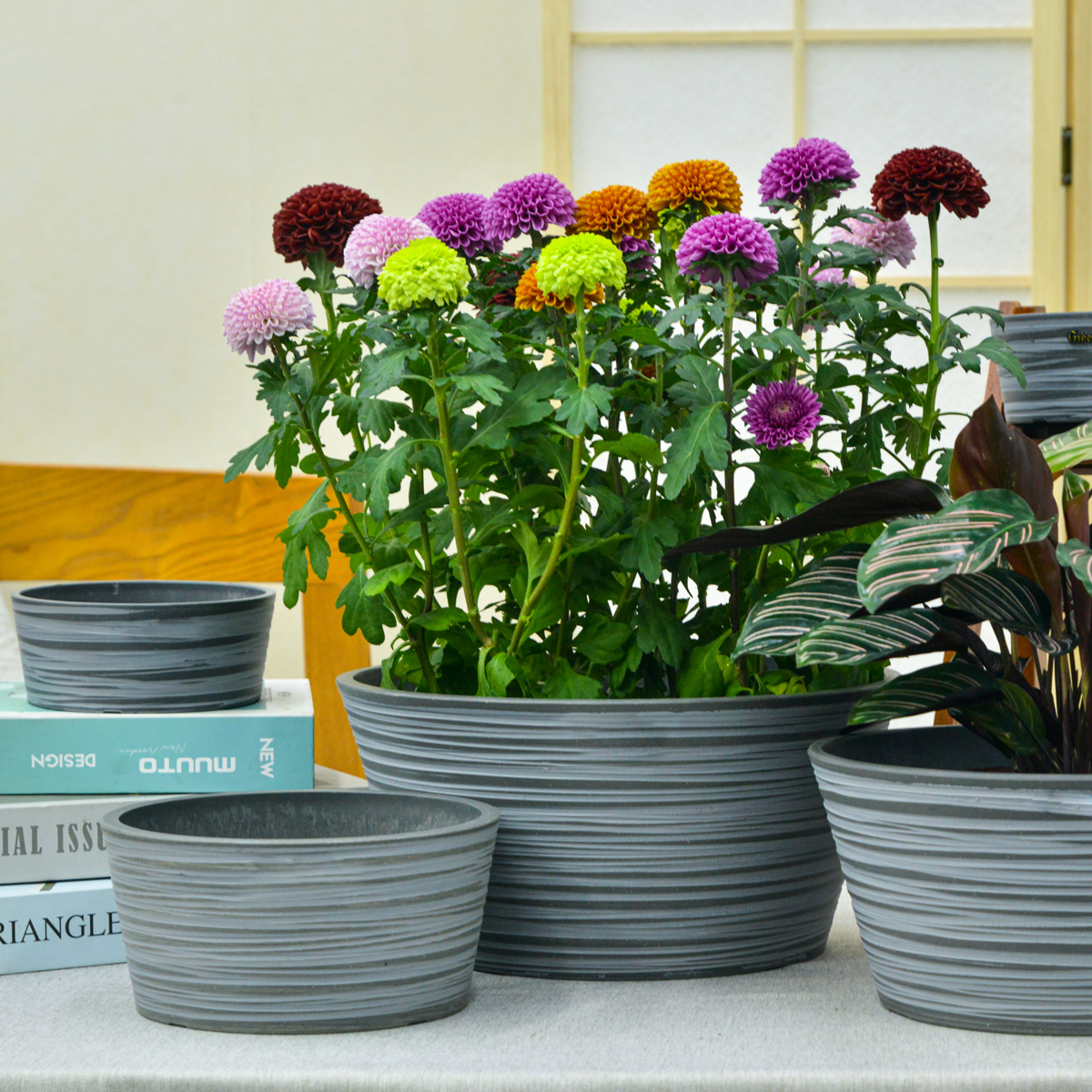Basil Indoors: The Complete Guide to Growing Ocimum Basilicum at Home
Want to enjoy the fresh, vibrant flavor of basil year-round, right from your kitchen windowsill? Basil, scientifically known as Ocimum basilicum, is a beloved culinary herb prized for its aromatic leaves and distinctive sweet-peppery flavor. While traditionally grown outdoors in summer gardens, basil is also a fantastic and incredibly easy-to-grow indoor plant, bringing a touch of fresh flavor and culinary convenience to your home. This comprehensive guide will provide you with everything you need to know to grow Ocimum basilicum indoors, from selecting the right variety and pot to mastering essential care techniques for a thriving and flavorful basil plant in your home.

Basil
What is Basil (Ocimum basilicum)?
Ocimum basilicum, commonly known as Basil, Sweet Basil, or Genovese Basil, is a culinary herb of the family Lamiaceae (mints), native to tropical regions from central Africa to Southeast Asia. Basil is an annual plant (though it can be perennial in very warm climates) characterized by its fragrant, oval, often bright green leaves (though varieties come in purple, red, and variegated forms) and its distinctive sweet, slightly peppery flavor with hints of anise and clove. Basil is a tender herb that grows quickly in warm conditions. Indoors, basil is primarily grown for its culinary use, providing a readily available source of fresh leaves for cooking, salads, and pesto. Basil is prized for its fresh, aromatic leaves, culinary versatility, rapid growth, and ease of indoor cultivation, making it a must-have herb for any indoor kitchen garden.
Can Basil (Ocimum basilicum) Thrive Indoors?
Yes, Basil (Ocimum basilicum) can thrive indoors and is one of the easiest and most rewarding herbs to grow inside your home. With the right conditions, basil will flourish on a sunny windowsill or under grow lights, providing a continuous supply of fresh, flavorful leaves for your culinary needs. Growing basil indoors allows you to enjoy this summer herb year-round, regardless of the outdoor season or climate, and it’s a perfect project for beginner gardeners.
Ideal Indoor Growing Conditions for Basil (Ocimum basilicum):
- Varieties of Basil (Ocimum basilicum) for Indoors: While many basil types can be grown indoors, some are particularly well-suited for container growing and indoor environments due to their compact size or growth habits. Popular indoor Basil varieties include:
- *Ocimum basilicum ‘Sweet Basil’: The classic Genovese basil, widely used in Italian cuisine, reliable and flavorful.
- *Ocimum basilicum ‘Dwarf Bush Basil’: Compact and bushy varieties like ‘Spicy Globe’ or ‘Bush Basil’, ideal for small pots and windowsills.
- *Ocimum basilicum ‘Greek Basil’: Small, compact leaves, strong flavor, drought-tolerant, good for containers.
- *Ocimum basilicum ‘Purple Basil’: Varieties like ‘Purple Ruffles’ or ‘Opal Basil’, add color and visual appeal, flavor is slightly different from sweet basil.
- *Ocimum basilicum ‘Lemon Basil’: Citrusy lemon scent and flavor, great for teas and salads.
- *Ocimum basilicum ‘Thai Basil’: Anise-licorice flavor, essential for Southeast Asian cuisine, more heat-tolerant than sweet basil.
- Light: Basil needs bright light to thrive indoors. It is a sun-loving herb and requires at least 6-8 hours of direct sunlight per day to grow vigorously, produce flavorful leaves, and prevent legginess. South-facing windows are ideal, providing the most intense sunlight. West-facing windows can also work if they offer several hours of direct afternoon sun. East-facing windows may provide sufficient light during summer, but may need supplemental lighting in winter or less sunny locations. Insufficient light will result in weak, leggy growth, pale leaves, and reduced flavor. Supplement natural light with grow lights (full-spectrum LED grow lights are recommended) to provide adequate light intensity and duration, especially during winter months or in less sunny homes. Place grow lights a few inches above the plant canopy and keep them on for 12-14 hours per day.
- Soil: Basil needs well-draining, fertile soil that retains moisture. Use a high-quality potting mix that is rich in organic matter. A general-purpose potting mix amended with compost or well-rotted manure is ideal. You can also add perlite or vermiculite to improve drainage and aeration, though this is less critical than for some other herbs. Basil prefers slightly acidic to neutral pH (pH 6.0-7.0).
- Watering: Basil prefers consistently moist soil, but not waterlogged. Water thoroughly when the top inch of soil is just beginning to dry out. Water deeply until water drains out of the drainage holes. Allow the very top surface of the soil to slightly dry between waterings, but do not let the soil dry out completely, especially during active growth. Basil is sensitive to both overwatering and underwatering. Overwatering can lead to root rot and fungal diseases, while underwatering will cause wilting, leaf drop, and stress. Watering frequency will vary depending on light levels, temperature, humidity, pot size, and growth rate. Check soil moisture regularly by feeling the soil. Use room temperature water.
- Temperature: Basil thrives in warm temperatures, ideally between 60°F to 80°F (15°C to 27°C). It is a heat-loving herb and prefers warm conditions year-round. Avoid exposing it to temperatures below 50°F (10°C) or sudden temperature fluctuations and cold drafts. Basil is very sensitive to frost and cold.
- Humidity: Basil prefers moderate humidity. Average household humidity is generally sufficient. While it appreciates some humidity, excessively high humidity combined with poor air circulation can increase the risk of fungal diseases. Good air circulation is more important than high humidity. Avoid overly humid environments and ensure good ventilation.
Planting Your Basil (Ocimum basilicum) Indoors:
- Starting from Seed or Seedlings/Potted Plants: Basil is very easy to start from seed indoors. You can also purchase basil seedlings or small potted plants from nurseries, garden centers, or grocery stores. Starting from seed is a cost-effective and rewarding way to grow basil indoors.
- Starting from Seed: Sow basil seeds indoors 4-6 weeks before the last expected frost in spring if you plan to move them outdoors later, or anytime you want to grow basil indoors year-round. Sow seeds in seed-starting mix, keep consistently moist and warm (70-80°F/21-27°C), and provide bright light once seedlings emerge. Seeds typically germinate in 5-10 days.
- Transplanting Seedlings or Planting Potted Plants: Once seedlings have a few sets of true leaves or when planting a purchased potted plant, transplant them into their final pots.
Choosing the Right Pots for Indoor Basil (Ocimum basilicum):
- Suitable Pot Types: Select pots with good drainage. Terracotta pots, ceramic pots, or plastic pots are all suitable. Terracotta is often favored for herbs as it is porous and helps the soil dry out slightly, which basil appreciates.
- Drainage: Drainage is essential for Basil to prevent root rot. Ensure your chosen pot has drainage holes at the bottom. You can also add a thin layer of gravel or pot shards at the base of the pot to improve drainage.
- Pot Size: Choose a pot that is appropriately sized for the current size of the plant and allows for some growth. Basil is a relatively fast grower and will need some space for its roots to develop. For individual basil plants, pots that are 6-8 inches in diameter are a good starting size. For larger, bushier varieties or for planting multiple basil plants together, use pots that are 8-12 inches in diameter or larger. You can also grow basil in window boxes or long planters.
- Potting Mix: Use a high-quality, well-draining potting mix as described earlier (general-purpose mix amended with compost).
Essential Care Tips for a Thriving Indoor Basil Plant (Ocimum basilicum):
- Watering Schedule: “Keep Soil Moist, Allow Topsoil to Slightly Dry”. Water thoroughly when the top inch of soil is just starting to dry out. Allow the very surface to slightly dry between waterings. Avoid overwatering and soggy soil.
- Light Management: Bright Light is Essential. Provide at least 6-8 hours of direct sunlight per day, or supplement with grow lights to ensure vigorous growth and flavorful leaves.
- Pinching and Pruning (Regularly for Bushiness and Harvest): Pinch off the top set of leaves on young basil plants when they are about 4-6 inches tall to encourage branching and bushier growth. Regularly prune or harvest basil leaves by pinching or cutting stems just above a leaf node (where leaves grow from the stem). This encourages new growth from below the cut and keeps the plant productive and bushy. Regular harvesting is essential to prevent basil from flowering and going to seed, which can reduce leaf production and flavor.
- Fertilizing (Light Feeding, Occasionally): Basil is not a heavy feeder, but benefits from light fertilization, especially when actively growing. Fertilize every 4-6 weeks during the growing season (spring and summer)with a balanced liquid fertilizer (10-10-10 or similar) diluted to half strength, or an herb-specific fertilizer. Follow package instructions carefully. Avoid over-fertilizing, which can reduce flavor intensity.
- Air Circulation is Beneficial: Ensure good air circulation around your indoor basil plant to help prevent fungal diseases and promote healthy growth. Open windows occasionally (when temperatures are suitable) or use a small fan to improve air movement.
- Repotting (Usually Not Needed for Annual Basil): As basil is typically grown as an annual, repotting is usually not necessary within its lifespan. However, if your basil plant becomes root-bound in its pot or you want to move it to a slightly larger container, you can repot it gently in spring or early summer.
- Pest and Disease Control: Indoor basil is relatively pest and disease-resistant if grown in proper conditions. Monitor for occasional pests like aphids or spider mites. Fungal diseases like powdery mildew or downy mildew can occur if humidity is too high and air circulation is poor. Ensure good air circulation and avoid overcrowding. Avoid overhead watering, and water at the base of the plant. Treat any pest infestations promptly with insecticidal soap or neem oil. For fungal issues, improve air circulation, reduce humidity if excessive, and use a fungicide if necessary.
- Harvesting: Harvest basil leaves regularly, starting when plants are about 6-8 inches tall. Pinch or cut off leaves as needed for culinary use. For larger harvests, you can cut stems back by about 1/3, encouraging new growth. Harvest basil before it flowers for the best flavor and leaf production. Once basil starts to flower, leaf production and flavor decline. You can pinch off flower buds to prolong leaf production, but eventually, basil will naturally complete its life cycle.
Popular Basil Cultivars for Indoor Growing (within Ocimum basilicum):
- *Ocimum basilicum ‘Sweet Basil’ (Classic Sweet Basil)
- *Ocimum basilicum ‘Spicy Globe’ (Dwarf Bush Basil)
- *Ocimum basilicum ‘Bush Basil’ (Dwarf Bush Basil)
- *Ocimum basilicum ‘Greek Basil’ (Small Leaf Basil)
- *Ocimum basilicum ‘Purple Opal’ (Purple Basil)
- *Ocimum basilicum ‘Lemon Basil’ (Lemon Scented Basil)
- *Ocimum basilicum ‘Thai Basil’ (Thai Basil)
In Summary:
Growing Basil (Ocimum basilicum) indoors is a simple and rewarding way to bring fresh, flavorful herbs right into your kitchen. Its ease of growth, rapid production, and culinary versatility make it a perfect choice for beginner and experienced indoor gardeners alike. By providing bright light, well-draining potting mix in pots with drainage, watering to keep soil consistently moist, pinching and pruning regularly, and harvesting frequently, you can easily cultivate thriving and productive basil plants indoors and enjoy fresh, home-grown basil year-round

Basil
For more detailed botanical information and to explore the diversity of Ocimum basilicum, you can visit the Wikipedia page on Ocimum basilicum.
Important Note: Basil (Ocimum basilicum) is considered non-toxic to humans and pets and is widely used in culinary applications. The primary care challenges with indoor basil are providing sufficient bright light and consistent moisture without overwatering. With attention to these key needs and regular harvesting, you can enjoy fresh, home-grown basil indoors for all your cooking needs.
Planter 6 in W / 8 in W / 12 in W Indoor or Outdoor Plants, Modern Decorative Plant Pots with Drainage Hole, Decorative Flower Pots
By greenship-seo|2025-02-06T13:43:53+00:00January 16, 2025|Categories: Hand-carving Series|Tags: Decorative Flower Pots|
KC2-21G
By greenship|2024-08-13T06:19:08+00:00August 13, 2024|Categories: Hand-carving Series|
20YB
By greenship|2024-08-16T05:37:57+00:00August 16, 2024|Categories: Hand-carving Series|
KC3-14A
By greenship|2024-08-16T06:26:30+00:00August 16, 2024|Categories: Hand-carving Series|
k2-21G
By greenship|2024-08-13T06:17:26+00:00August 13, 2024|Categories: Hand-carving Series|
11THD
By greenship|2024-08-13T02:52:20+00:00August 13, 2024|Categories: Hand-carving Series|






